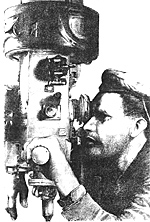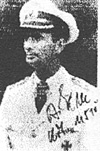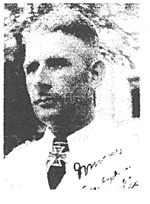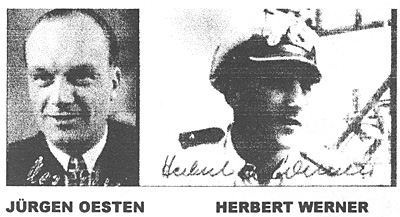
PETER HANSEN (251-LIFE-1987) spent time working for the ABWEHR (the German Secret Service) during WW II and he has information that is known to a mere handful of people. He gives this secret information especially to SHARKHUNTERS. Here he tells us:
When the USN Task Group headed by the carrier USS MISSION BAY, found U-1062 and the destroyer USS FESSENDEN sank the U-boat, it was U-1062 herself who led the Task Group to them U-1062 was located from Ultra-originated orders, when Ultra received a `short signal' of U-1062 reporting her last position This was picked up and read by Bletchley Park and the Tenth Fleet tracking room.
Because U-boat Command, as so often, based their routing instructions on outdated obsolete material, such as periscope observations in 1941 and 1942 of the islands and ports of Asuncion, St. Helena and other such anchorages, many of the Monsun Boats were already destroyed in the Middle and South Atlantic, usually with Ultra directions towards their locations on the way towards South Africa and the Far east. Several U-boats that managed to pass that area were later on sunk in the Indian Ocean or the Arabian Gulf Finally, a few that did reach the Southeast Asian bases without being sunk on the way somewhere, did not manage the equally dangerous long return voyages to Europe. It would lead too far and become too lengthy to list and mention all the U-boats that did not succeed in their intended plans, and the details of their losses and any sinkings they themselves did achieve, as this would be a long story by itself actually. Consequently, I shall only reflect those that reached Penang or Japan, usually Sasebo or Kure somehow, and operated some patrols on circular basis from the Far East or in the Pacific and those that almost made it back in addition to those U-boats that did indeed manage the complete round trip.
 Type IX-C40 boat U-510 under ALFRED EICK (5941-1999), Class of 1937-A(IV/37) departed Lorient on November 3rd, 1943 and arrived at Penang on April 15th 1944. U-510 proceeded eventually to Japan and arrived there for overhaul because the Singapore drydock, the only one available, could not be obtained due to the Japanese own needs for same.
Type IX-C40 boat U-510 under ALFRED EICK (5941-1999), Class of 1937-A(IV/37) departed Lorient on November 3rd, 1943 and arrived at Penang on April 15th 1944. U-510 proceeded eventually to Japan and arrived there for overhaul because the Singapore drydock, the only one available, could not be obtained due to the Japanese own needs for same.
U-510 first sailed from Japan on November 26th, 1944 but had to return due to mechanical problems, then departing again on December 3rd, 1944 and finally reaching the besieged 'Sea Fortress' of St Nazaire in France on April 24, 1945. Because no refueling was possible anymore in the Atlantic and it could not reach Norway due to lack of fuel, U-510 was surrendered to the French on May 12th, 1945. The French kept her in service, operating under the name BOUAN, until 1959. EICK selected St. Nazaire in preference to Lorient, which was at that time likewise surrounded, because it had deeper water approaches and required fewer navigational beacon aides.
U-532 under the command of Fregattenkapitan Otto Junker, Class of 1924, departed from Lorient on July 3rd, 1943 and reached Penang on October 31, 1943. U-532 left Penang again on January 4, 1944 for a patrol in the Indian Ocean and returned to Penang for a second time on April 19, 1944. Thereafter U-532 traveled to Japan for final loading and left Japan on January 13th, 1945 reaching European waters at the beginning of May 1945, when U-532 went to Liverpool for surrender on May 13, 1945 where U-532 was immediately inspected by Admiral Sir Max Horton, the Commander of Western Approaches and his staff. Captain Junker had been the aide-de-camp of Grossadmiral Raeder at the OKM (OberKommandoderMarine or Naval High Command) and carried on for a few weeks after Karl Donitz replaced him, before taking command of U-532, after Han Heinrich `Hanschen' HansenNoctbar in turn became the new adjutant for Karl Donitz.
 U-178, Type IX-D2, departed from Bordeaux on March 28h, 1943 under Wilhelm Dommes and as already mentioned, reached Penang on August 29th, 1943.
U-178, Type IX-D2, departed from Bordeaux on March 28h, 1943 under Wilhelm Dommes and as already mentioned, reached Penang on August 29th, 1943.
U-178 departed from Penang under Wilhelm Spahr on November 27th, 1943 and reached Bordeaux, France on May 24, 1944. It was never repaired or overhauled again, and was stripped for parts before being surrendered in the Bordeaux sub pens to the French.
U-188, another Type IX-C40 boat under the command of Korvettenkapitan Siegfried Ludden, Class of 1936, left Lorient on June 30th, 1943 and reached Penang on October 31, 1943. U-188 left Penang again on January 9, 1944 and returned to Bordeaux on June 9th , 1944 where it also was surrendered in the Bordeaux sub pens on August 20th, 1944 when the French occupied this U-boat base that had been vacated by the Germans.
Supposedly U-178 as well as U-188 were non-operable and stripped down as much as possible before the staff retreated to La Rochelle instead.
 Finally, U-861 under the command of Korvettenkapitan JURGEN OESTEN (1681-LIFE-1990), another Type IX-D2 boat, sailed from Kiel in Germany on April 20th, 1944 and arrived at Penang on September 22nd, 1944 somewhat earlier than anticipated, so that the British submarine HMS TRENCHANT sunk U-859 instead. HMS TRENCHANT arrived delayed at the assigned position in the Penang Channel. U-861 departed Penang on January 14th, 1945 and reached Trondheim, Norway on April 18, 1945. Here it was moored outside the bunker, next to U-953 which HERBERT WERNER (18-C-1983) had brought into that port on April 4, 1945. U-861 was surrendered there and scuttled in Operation Deadlight by the British.
Finally, U-861 under the command of Korvettenkapitan JURGEN OESTEN (1681-LIFE-1990), another Type IX-D2 boat, sailed from Kiel in Germany on April 20th, 1944 and arrived at Penang on September 22nd, 1944 somewhat earlier than anticipated, so that the British submarine HMS TRENCHANT sunk U-859 instead. HMS TRENCHANT arrived delayed at the assigned position in the Penang Channel. U-861 departed Penang on January 14th, 1945 and reached Trondheim, Norway on April 18, 1945. Here it was moored outside the bunker, next to U-953 which HERBERT WERNER (18-C-1983) had brought into that port on April 4, 1945. U-861 was surrendered there and scuttled in Operation Deadlight by the British.
Finally, the ‘almost' round trip U-boat, U-843, also a Type IX-C40 U-boat under the command of Oskar Herwartz, Class of 1935, which departed from France on February 19, 1944 and traveled directly for Japan, arriving there on June 11th, 1944. U-843 left Japan again on Dec. 10th, 1944 and traveled past Norway, entering the Kattegat area between Denmark and Sweden, proceeding to Germany when U-843 was bombed on April 19, 1945 off Frederickshaven, Denmark by British aircraft and sunk in shallow water. Herwartz traveled by surface means to Kiel and literally besieged R.Admiral EBERHARD GODT (344-+-1987) in U-boat Command to ferret out heavy lift tugs. But GODT told him: "It is too late. We just can't find anything like that anymore. The British bombed everything to pieces already. "
Herwartz wanted to recover the extremely valuable load, but nothing was done anymore in that respect, as the handwriting for the end was clearly visible! But `A' for effort should be given to Oskar Herwartz anyway.
As always, PETER HANSEN (251-LIFE-1987) gives us a look into the U-Bootwaffe that can come from nowhere else. Many thanks PETER. We look forward to seeing you in Germany soon.
Back to KTB # 154 Table of Contents
Back to KTB List of Issues
Back to MagWeb Master Magazine List
© Copyright 2001 by Harry Cooper, Sharkhunters International, Inc.
This article appears in MagWeb.com (Magazine Web) on the Internet World Wide Web. Other articles from military history and related magazines are available at http://www.magweb.com
Join Sharkhunters International, Inc.: PO Box 1539, Hernando, FL 34442, ph: 352-637-2917, fax: 352-637-6289, www.sharkhunters.com
